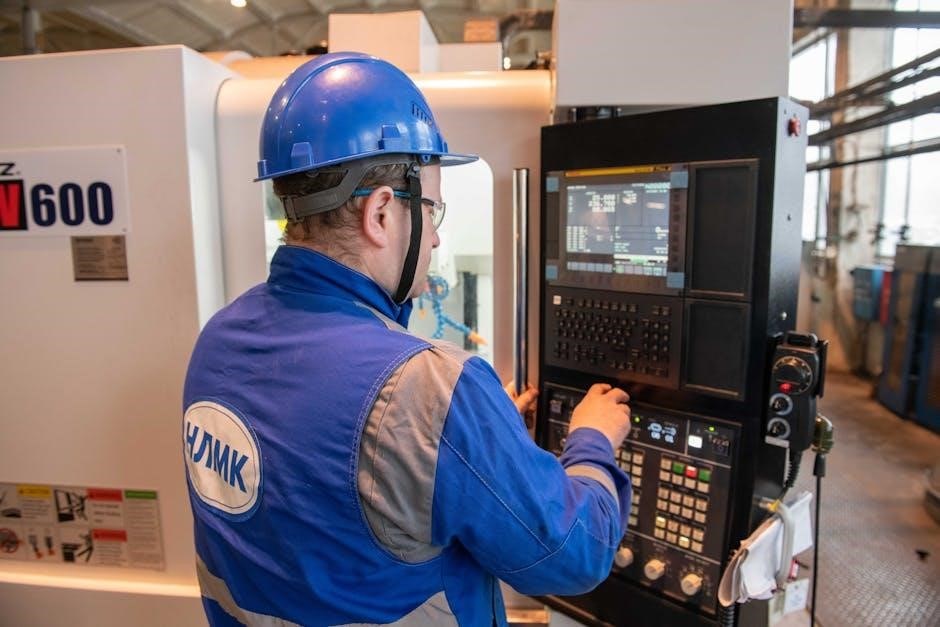Understanding the sequence of operation for gas furnaces is crucial for ensuring safety‚ efficiency‚ and proper functionality․ This guide provides a detailed breakdown of how gas furnaces operate‚ helping homeowners and technicians identify and address issues effectively․
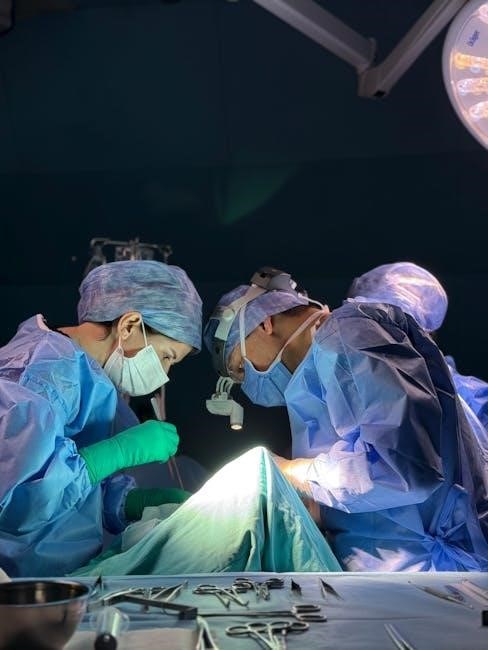
Overview of Gas Furnaces
A gas furnace is a central heating system that burns natural gas or propane to generate heat for homes․ It operates by circulating heated air through ducts‚ providing warmth to various rooms․ These furnaces are known for their efficiency and reliability‚ making them a popular choice for many households․ Modern gas furnaces often feature advanced technologies‚ such as direct ignition and high-efficiency burners‚ which enhance performance and reduce energy consumption․ Understanding the sequence of operation is essential for troubleshooting and maintaining these systems․ Regular maintenance‚ including cleaning filters and inspecting components‚ ensures optimal functionality․ Additionally‚ gas furnaces are generally more cost-effective and environmentally friendly compared to older heating systems․ This overview provides a foundation for grasping how these systems work and why their proper operation is vital for home comfort․
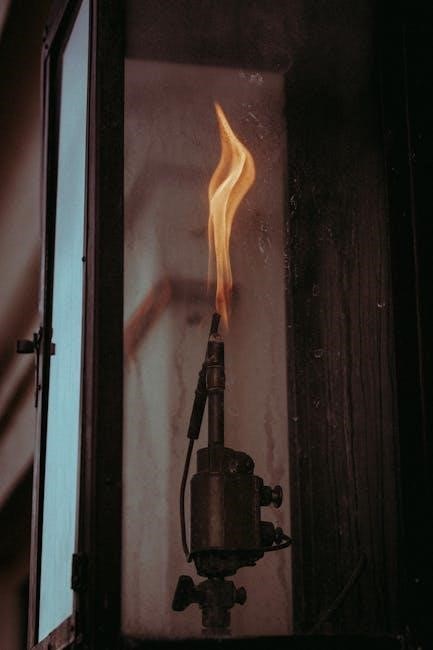
Importance of Understanding the Sequence of Operation
Comprehending the sequence of operation for a gas furnace is vital for ensuring safety‚ efficiency‚ and cost savings․ By understanding each step in the process‚ homeowners and technicians can identify potential issues early‚ preventing costly repairs and maintaining optimal performance․ This knowledge also enhances troubleshooting capabilities‚ allowing for faster diagnosis and resolution of problems․ Furthermore‚ a well-operating furnace reduces energy consumption‚ lowering utility bills and environmental impact․ Regular maintenance and informed repairs extend the furnace’s lifespan‚ ensuring reliable heating during harsh winter months․ Without this understanding‚ minor issues can escalate‚ leading to system failures or even safety hazards․ Thus‚ familiarity with the sequence of operation is essential for maximizing the benefits of a gas furnace while minimizing risks and expenses․
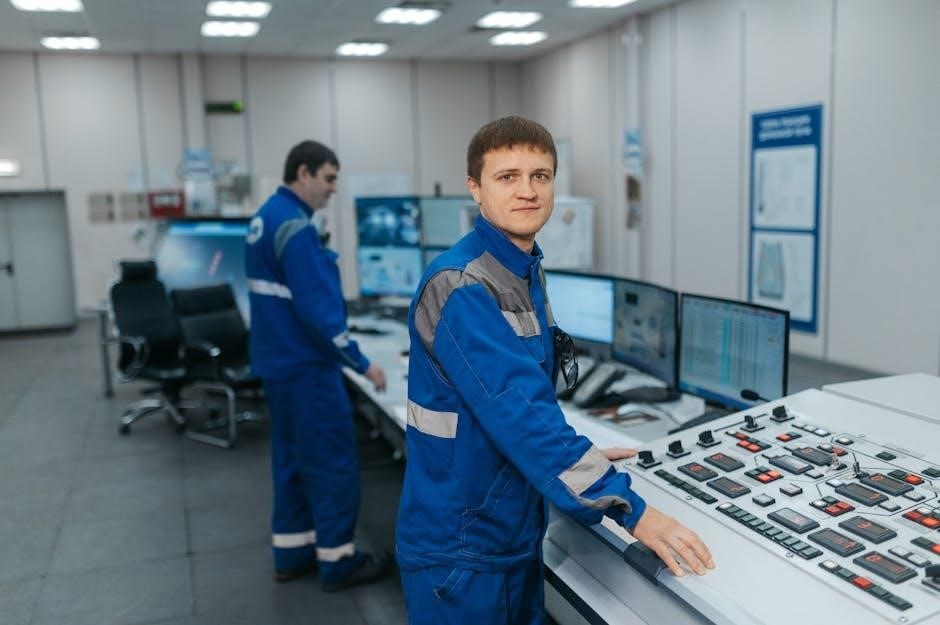
Sequence of Operation for Gas Furnaces
The sequence of operation for gas furnaces involves a series of steps ensuring safe and efficient heating․ Understanding these steps is crucial for diagnostics and maintenance․
Thermostat Signal Initiation
The process begins with the thermostat detecting a drop in room temperature below the set point․ Once this occurs‚ the thermostat sends an electrical signal to the gas furnace control board‚ initiating the heating cycle․ This signal is the starting point of the sequence of operation‚ ensuring the furnace responds to the demand for heat․ The control board processes the signal and prepares the system for safe ignition․ This step is critical‚ as it ensures the furnace operates only when necessary‚ maintaining energy efficiency and safety․ Proper functioning of the thermostat and its communication with the furnace are essential for reliable performance․ Any issues in this phase can prevent the furnace from turning on‚ highlighting the importance of accurate signal transmission․ This initial step sets the stage for the subsequent stages of the gas furnace operation‚ including draft inducer activation and ignition․
Draft Inducer Motor Activation
Following the thermostat signal‚ the draft inducer motor activates to ensure proper ventilation within the gas furnace system․ This motor creates a negative pressure environment‚ crucial for safely venting combustion gases through the chimney or venting system․ The draft inducer operates before ignition to clear the venting pathways‚ ensuring no residual gases remain that could cause unsafe conditions․ Its operation is monitored by the furnace control board‚ which verifies proper function before proceeding to the ignition phase․ If the draft inducer fails to activate or function correctly‚ the furnace will not proceed further‚ preventing potential safety hazards․ This step is vital for maintaining efficient and safe gas furnace operation‚ as improper venting can lead to carbon monoxide buildup or other dangerous situations․ Regular maintenance of the draft inducer motor is essential to ensure reliable performance during the heating cycle․
Ignition System Process
The ignition system process begins once the draft inducer motor has ensured proper ventilation․ The gas furnace control board sends a signal to the ignition system‚ which typically involves either a direct spark ignition or a hot surface igniter․ In modern furnaces‚ a silicon carbide igniter is commonly used to generate a high-voltage spark or glow‚ igniting the pilot gas․ Once the pilot flame is established‚ a flame sensor verifies its presence by detecting the electrical current generated by the flame․ This confirmation allows the control board to proceed with the next step in the sequence․ If the ignition system fails to light the pilot or the flame sensor does not detect a flame‚ the furnace will shut down to prevent unsafe conditions․ Proper ignition is critical for safe and efficient operation of the gas furnace․ Regular maintenance of the ignition components ensures reliable performance during the heating cycle․
Main Burner Ignition
The main burner ignition occurs after the pilot flame has been successfully established and verified by the flame sensor․ The furnace’s control board sends a signal to open the main gas valves‚ allowing natural gas to flow into the burner assembly․ The pilot flame then ignites the gas in the main burners‚ creating a larger‚ more robust flame․ This process is typically accompanied by a noticeable “whooshing” sound as the gas ignites․ Modern furnaces often use advanced ignition systems‚ such as direct spark or hot surface ignition‚ to ensure reliable and efficient combustion․ The control board continuously monitors the burner flame to ensure it remains stable and within safe parameters․ If the main burners fail to ignite or the flame is unstable‚ the system will shut down to prevent unsafe conditions․ Proper main burner ignition is essential for achieving optimal heating performance and energy efficiency․ Regular maintenance‚ such as cleaning the burners and ensuring proper gas flow‚ helps prevent ignition issues․
Heat Exchanger Warm-Up
The heat exchanger warm-up phase is a critical step in the gas furnace sequence of operation; After the main burners ignite‚ the heat exchanger begins to warm up․ This process ensures that the heat exchanger reaches a safe operating temperature before the blower motor starts circulating air․ The control board monitors this phase‚ often using a sensor or timer‚ to prevent cold air from being distributed․ Proper warm-up is essential for efficiency and safety‚ as it allows the heat exchanger to transfer heat effectively from the combustion gases to the surrounding air․ Any blockages or issues during this phase can lead to inefficiency or potential damage․ Regular maintenance‚ such as cleaning the heat exchanger and ensuring proper airflow‚ helps maintain optimal performance․ The heat exchanger warm-up is a vital step in preparing the furnace to provide consistent and reliable heat․
Blower Motor Activation
The blower motor activation occurs after the heat exchanger has sufficiently warmed up‚ ensuring that only heated air is circulated through the ductwork․ This step is triggered by the control board‚ which monitors the system’s temperature and operating parameters․ Once the heat exchanger reaches the desired temperature‚ the blower motor begins to operate‚ drawing air from the return ducts and circulating it through the furnace’s heat exchanger․ The heated air is then distributed throughout the home via supply ducts․ Proper activation of the blower motor ensures efficient heating and maintains consistent temperatures․ If the blower motor fails to activate‚ it can result in reduced airflow and inefficient heating․ Regular maintenance‚ such as cleaning the blower motor and ensuring proper electrical connections‚ is essential for reliable operation․ This step is critical for maintaining comfort and energy efficiency in a gas furnace system․

Heated Air Distribution
The heated air distribution phase begins once the blower motor is actively circulating warm air through the ductwork․ This process ensures that the heated air produced by the furnace is evenly distributed throughout the home․ The blower motor pulls cooler air from return ducts‚ passes it over the heat exchanger‚ and then pushes the warmed air into supply ducts․ This cycle continues until the desired temperature‚ set by the thermostat‚ is achieved; Proper air distribution is critical for maintaining consistent temperatures and comfort levels in all areas of the home․ Issues such as blocked ducts or leaks can disrupt this process‚ leading to uneven heating․ Regular maintenance of the ductwork and blower motor is essential to ensure efficient and reliable heated air distribution․ This step is vital for maximizing the efficiency and performance of the gas furnace system․

Thermostat Satisfaction and Shutdown
Once the desired temperature is reached‚ the thermostat signals the gas furnace to cease operation․ This phase ensures energy efficiency by preventing overheating and unnecessary fuel consumption․ The thermostat monitors the ambient temperature and compares it to the setpoint․ When the setpoint is met‚ it sends a signal to the furnace’s control board to initiate shutdown․ The shutdown sequence involves terminating the gas supply‚ extinguishing the burners‚ and de-energizing the draft inducer motor․ The blower motor may continue to run for a short period to circulate residual heat from the exchanger․ This process ensures safe and efficient operation‚ maintaining comfort while minimizing energy usage․ Proper thermostat calibration and functionality are essential for accurate temperature control and reliable system shutdown․ Regular checks on the thermostat can help prevent issues and ensure optimal performance of the heating system․

Troubleshooting Common Issues
Identify common gas furnace problems like failure to start‚ insufficient heat‚ or short cycling․ Diagnose the root cause by reviewing the sequence of operation and addressing faulty components․
Furnace Not Turning On
If your gas furnace fails to turn on‚ start by checking the thermostat settings․ Ensure it is set to “heat” mode and the desired temperature is higher than the current room temperature․ Verify that the circuit breaker or fuse controlling the furnace is functioning properly․ A tripped breaker or blown fuse can prevent the furnace from activating․ Next‚ inspect the gas supply line to confirm that the valve is fully open․ If these steps don’t resolve the issue‚ examine the ignition system‚ such as the pilot light or ignition sensor‚ for any signs of malfunction․ Consult the sequence of operation guide to trace the problem systematically․ If no obvious issues are found‚ contact a licensed HVAC technician to diagnose and repair complex faults‚ ensuring your heating system operates safely and efficiently․
Furnace Not Heating
If your gas furnace is not heating‚ it may indicate issues within the heating cycle․ Check the thermostat to ensure it is functioning correctly and set to “heat” mode․ Verify that the gas supply is open and the pilot light is lit if applicable․ A faulty ignition system‚ such as a failed hot surface igniter or damaged flame sensor‚ can prevent the burners from lighting․ Additionally‚ a blocked or dirty heat exchanger can disrupt heat production․ Inspect the venting system for obstructions‚ as improper ventilation can cause the furnace to shut down․ If the blower motor is not operating‚ it may prevent heated air from circulating․ Consult the sequence of operation guide to identify where the process is failing․ Addressing these issues promptly ensures your furnace resumes heating efficiently and safely․
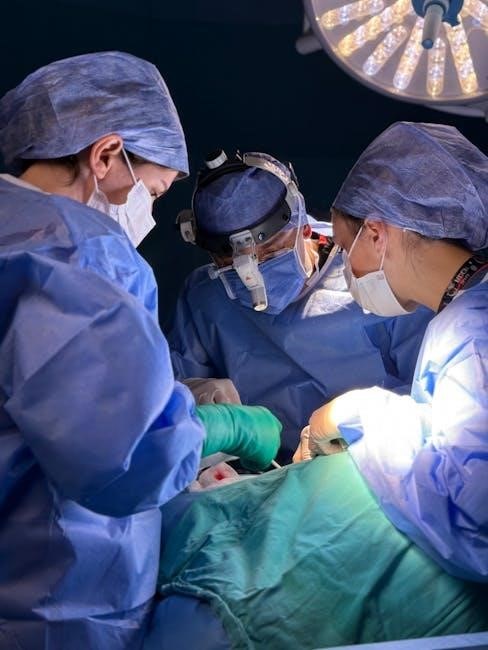
Short Cycling Issues
Short cycling occurs when a gas furnace turns on and off frequently‚ not completing a full heating cycle․ This issue can reduce efficiency and increase wear on the system․ Possible causes include a malfunctioning thermostat‚ improper furnace sizing‚ or restricted airflow․ A faulty temperature sensor or ignition system may also disrupt the cycle․ Check for blockages in vents or filters‚ as these can trigger safety shutdowns․ Ensure the thermostat is calibrated correctly and placed away from drafts․ If the heat exchanger overheats‚ it may cause the furnace to cycle short․ Refer to the sequence of operation guide to identify where the cycle is being interrupted․ Addressing these issues promptly can restore normal operation and prevent long-term damage to the furnace․ Regular maintenance and professional inspections are recommended to avoid recurring short cycling problems․

Maintenance and Safety
Regular maintenance and safety checks are essential for optimal gas furnace performance and hazard prevention․ Ensure annual professional inspections‚ clean filters‚ and inspect components for wear or damage․
Regular Maintenance Tasks
Regular maintenance is vital to ensure your gas furnace operates efficiently and safely․ Key tasks include changing or cleaning air filters monthly‚ inspecting venting systems for blockages‚ and ensuring proper ignition system function․ Annual professional tune-ups are recommended to identify potential issues early․ Additionally‚ homeowners should check for worn or damaged components‚ such as belts or heat exchanger cracks‚ and address them promptly․ Cleaning the furnace cabinet and surrounding areas from debris helps maintain airflow and performance․ By adhering to these routine tasks‚ you can prevent unexpected breakdowns‚ improve energy efficiency‚ and extend the lifespan of your furnace․ Regular maintenance also ensures compliance with safety standards‚ reducing the risk of hazards like carbon monoxide leaks․

Safety Checks and Precautions
Safety is paramount when operating a gas furnace․ Regular inspections should include checking for carbon monoxide leaks‚ ensuring proper venting system function‚ and verifying that the flame sensor and ignition system are operating correctly․ Homeowners should never ignore unusual odors‚ sounds‚ or visible flames outside the furnace․ Annual professional inspections are essential to identify potential hazards․ Additionally‚ installing carbon monoxide detectors and ensuring they are functioning properly is critical․ Never attempt repairs without turning off the power and gas supply․ If a malfunction occurs‚ such as a gas leak or improper ignition‚ shut off the furnace and contact a certified technician immediately․ Keeping flammable materials away from the furnace and ensuring proper airflow are also vital precautions․ Neglecting these safety measures can lead to dangerous conditions‚ including fires or toxic gas exposure․
Professional Servicing Recommendations
Professional servicing is essential for maintaining the efficiency and safety of your gas furnace․ It is recommended to schedule an annual inspection with a certified HVAC technician before the heating season begins․ During the service‚ the technician will inspect critical components such as the heat exchanger‚ ignition system‚ and gas valves to ensure they are functioning properly․ They will also clean or replace the air filter‚ check for gas leaks‚ and verify the proper operation of the ventilation system․ Regular professional servicing can prevent potential breakdowns‚ improve energy efficiency‚ and extend the lifespan of your furnace․ Additionally‚ a technician can identify and address issues early‚ avoiding costly repairs down the line․ Always choose a licensed and experienced technician for servicing to ensure compliance with safety standards and optimal performance of your heating system․
Optimizing Furnace Performance
Optimizing your gas furnace’s performance involves regular maintenance‚ upgrading to programmable thermostats‚ and implementing zone control systems․ These strategies enhance efficiency‚ reduce energy costs‚ and improve comfort levels significantly․
Using Programmable Thermostats
Programmable thermostats are a key component in optimizing gas furnace performance․ These devices allow homeowners to pre-set temperature levels for different times of the day‚ reducing energy consumption during periods when heating is not needed․ By automating temperature adjustments‚ programmable thermostats ensure consistent comfort while minimizing energy waste․ They integrate seamlessly with the gas furnace sequence of operation‚ adjusting the system’s output based on programmed settings․ Modern programmable thermostats often include features like remote access via smartphones‚ geofencing‚ and smart learning capabilities‚ which further enhance efficiency․ Proper installation and programming are essential to maximize their benefits․ Upgrading to a programmable thermostat can significantly improve your furnace’s performance‚ lower utility bills‚ and extend the system’s lifespan․ This simple yet effective tool is a cornerstone of modern heating system optimization․
Zone Control Systems
Zone control systems offer advanced temperature management by dividing a home into distinct zones‚ each with independent heating requirements․ This setup allows precise control over where and when heat is delivered‚ enhancing comfort and energy efficiency․ By installing dampers in ductwork and zone-specific thermostats‚ homeowners can direct heat only to areas that need it․ This reduces energy waste and lowers utility bills․ Zone control systems integrate seamlessly with gas furnaces‚ optimizing their sequence of operation by adjusting airflow and heat distribution based on zone demands․ They are particularly beneficial in larger homes or those with varying heating needs across different rooms․ Proper installation ensures compatibility with the furnace’s operation‚ making zone control a smart upgrade for modern heating systems․ This tailored approach to heating improves overall system performance and homeowner satisfaction․
